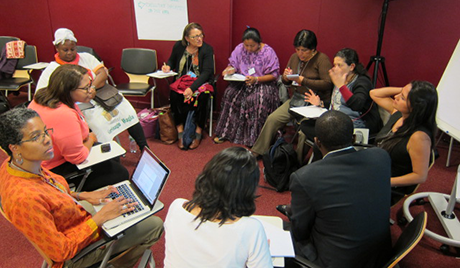
Participants at the first Community Practitioners Academy meeting, which was held ahead of the Fourth Global Platform for Disaster Reduction in Generva. - Photos: Margaret Arnold/World Bank
Communities are organized and want to be recognized as partners with expertise and experience in building resilience rather than as clients and beneficiaries of projects. This was the common theme that emerged from the key messages delivered by grassroots leaders at the Fourth Global Platform for Disaster Reduction taking place in Geneva this week, organized by the UN International Strategy for Disaster Reduction (UNISDR). The Global Platform is a biennial forum for information exchange and partnership building across sectors to reduce disaster risk.
Ahead of the Global Platform, 45 community practitioners from 17 countries - Bangladesh, Chile, Ethiopia, Guatemala, Haiti, Honduras, India, Indonesia, Japan, Kenya, Nicaragua, Peru, Philippines, Samoa, Uganda, Venezuela, and the United States - met for a day and a half to share their practices and experiences in responding to disasters and building long-term resilience to climate change, and to strategize their engagement in around the Global Platform. I had the privilege to participate in this first Community Practitioners Academy, which was convened by GROOTS International, Huairou Commission, UNISDR, the World Bank, Global Facility for Disaster Risk and Reduction (GFDRR), Act Alliance, Action Aid, Japan NGO Center for International Cooperation (JANIC), Cordaid, and Oxfam, and was planned in partnership with the community practitioners from their respective networks.
Margareta Wahlström, Special Representative of the UN Secretary-General for Disaster Risk Reduction, opened the Academy, recognizing that communities already come well organized, and urged them to engage actively in the Global Platform dialogue and to say what they are willing to take on to enable local resilience building.
In the sessions, Academy participants demonstrated just how much communities take on, and their expertise in dealing with all types of natural hazards, nuclear accidents, environmental degradation, land grabbing, climate change, conflict and epidemics — often in combination and on an ongoing basis. A sampling of some of these stories shows how much communities are involved in coping with disasters.
 Ichio Muto, a member of an organic farmers’ association in Japan, shared how the community responded to the Fukushima nuclear disaster following the 2011 earthquake, and how they are using organic farming methods to reduce the radiation level of crops. Deborah Katina of Kenya showcased her work with community women to mitigate drought risk by building sand dams for water storage. And from Nicaragua, Haydee Rodriguez, head of women’s farmer cooperative, explained how they are training local government officials on climate change adaptation and working with them and with the national government to facilitate community participation in national disaster risk management and reforestation policies.
Ichio Muto, a member of an organic farmers’ association in Japan, shared how the community responded to the Fukushima nuclear disaster following the 2011 earthquake, and how they are using organic farming methods to reduce the radiation level of crops. Deborah Katina of Kenya showcased her work with community women to mitigate drought risk by building sand dams for water storage. And from Nicaragua, Haydee Rodriguez, head of women’s farmer cooperative, explained how they are training local government officials on climate change adaptation and working with them and with the national government to facilitate community participation in national disaster risk management and reforestation policies.
The community practitioners and the experiences they shared were impressive, and I felt inspired by a few aspects that should be kept in mind as we ramp up efforts to support disaster and climate resilience building:
- Women are often the designers and builders of community resilience in poor communities. The leadership role played by women figured strongly in the Academy, and our research on disasters and climate change also reveals that women’s empowerment is a key ingredient to resilience building.
- Communities are dealing with localized, recurrent "everyday" disasters that are the results of persisting poverty, environmental degradation, social marginalization, and other factors unrelated to natural hazards. Godavari Dange, leader of a self-help women’s federation in Maharashtra, India, emphasized that over the years sugar and grape crops have drained the water, forcing them to dig over 1000 feet deep to collect water for drinking. All practitioners emphasized that they were not only working on reducing disaster risk, but on changing the way development is done. Understanding exposure to climate and hazard risk is important, but if we are to reduce climate risk, we need to focus strongly on addressing the underlying, non-climate related drivers of vulnerability.
- Community leaders not only build resilience at the local level, but can contribute as experts to policy making. Examples from Central America were particularly impressive. Grassroots women are training their governments, and participating in policy discussions at the local, national, and regional level. The governments of Guatemala and Honduras served as role models by including grassroots women on their official national delegations to the Global Platform.
The strategies that communities use to manage risk are poorly understood and often ignored by governments and development partners. We need a better understanding of the "autonomous adaptation" and social innovations that are taking place on a daily basis at the local level so that we can support it effectively. Leaders at the Community Practitioners Academy are committed to building partnerships at national and regional levels to amplify their networks, voices, practices, and impacts. We should take them up on this invitation.


Join the Conversation